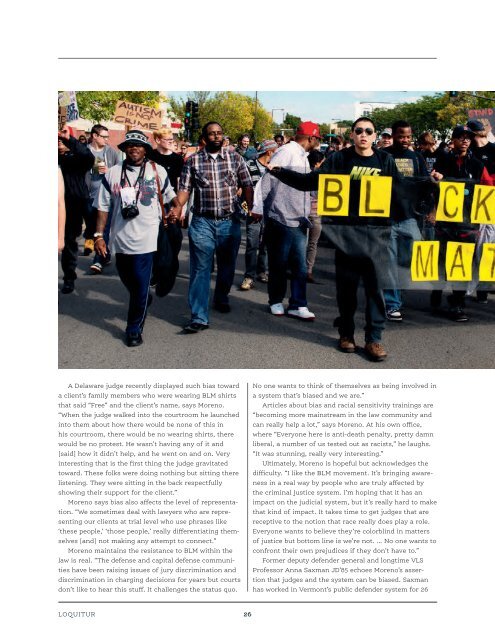In search of justice
fall2016_web
fall2016_web
Create successful ePaper yourself
Turn your PDF publications into a flip-book with our unique Google optimized e-Paper software.
A Delaware judge recently displayed such bias toward<br />
a client’s family members who were wearing BLM shirts<br />
that said “Free” and the client’s name, says Moreno.<br />
“When the judge walked into the courtroom he launched<br />
into them about how there would be none <strong>of</strong> this in<br />
his courtroom, there would be no wearing shirts, there<br />
would be no protest. He wasn’t having any <strong>of</strong> it and<br />
[said] how it didn’t help, and he went on and on. Very<br />
interesting that is the first thing the judge gravitated<br />
toward. These folks were doing nothing but sitting there<br />
listening. They were sitting in the back respectfully<br />
showing their support for the client.”<br />
Moreno says bias also affects the level <strong>of</strong> representation.<br />
“We sometimes deal with lawyers who are representing<br />
our clients at trial level who use phrases like<br />
‘these people,’ ‘those people,’ really differentiating themselves<br />
[and] not making any attempt to connect.”<br />
Moreno maintains the resistance to BLM within the<br />
law is real. “The defense and capital defense communities<br />
have been raising issues <strong>of</strong> jury discrimination and<br />
discrimination in charging decisions for years but courts<br />
don’t like to hear this stuff. It challenges the status quo.<br />
No one wants to think <strong>of</strong> themselves as being involved in<br />
a system that’s biased and we are.”<br />
Articles about bias and racial sensitivity trainings are<br />
“becoming more mainstream in the law community and<br />
can really help a lot,” says Moreno. At his own <strong>of</strong>fice,<br />
where “Everyone here is anti-death penalty, pretty damn<br />
liberal, a number <strong>of</strong> us tested out as racists,” he laughs.<br />
“It was stunning, really very interesting.”<br />
Ultimately, Moreno is hopeful but acknowledges the<br />
difficulty. “I like the BLM movement. It’s bringing awareness<br />
in a real way by people who are truly affected by<br />
the criminal <strong>justice</strong> system. I’m hoping that it has an<br />
impact on the judicial system, but it’s really hard to make<br />
that kind <strong>of</strong> impact. It takes time to get judges that are<br />
receptive to the notion that race really does play a role.<br />
Everyone wants to believe they’re colorblind in matters<br />
<strong>of</strong> <strong>justice</strong> but bottom line is we’re not. ... No one wants to<br />
confront their own prejudices if they don’t have to.”<br />
Former deputy defender general and longtime VLS<br />
Pr<strong>of</strong>essor Anna Saxman JD’85 echoes Moreno’s assertion<br />
that judges and the system can be biased. Saxman<br />
has worked in Vermont’s public defender system for 26<br />
LOQUITUR 26


